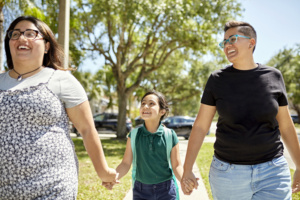AAA’s School’s Open – Drive Carefully campaign was launched in 1946 to help reduce the number of school-related pedestrian injuries and fatalities.
According to the National Center for Education Statistics, 55.4 million children (Pre-K through 12) are enrolled in school. Drivers are encouraged to stay alert in areas where children are present, paying special attention during the morning and afternoon hours while children are coming to and from school.
Every fall, millions and millions of children across the United States head back to school. Since many of those children typically walk or bike to school, AAA warns drivers to be especially vigilant for pedestrians before and after school hours.
Having a heightened sense of awareness of children and following the practices below will help to keep your drive and children safe:
TIPS FOR SAFETY
1. Review Your Travel Route. Drivers can consider modifying their travel routes to avoid school zones and residential neighborhoods. A slightly longer route might actually be quicker by avoiding congestion and much lower speed limits in and around school zones.
2. Allot Extra Travel Time. Back to school often means increased congestion and longer commute times. Mornings can be especially stressful. Drivers should allow extra travel time when school is in session to avoid any temptation to speed or disobey traffic laws in an effort to ‘catch up’ after being delayed.
3. Slow down. Speed limits in school zones are reduced for a reason. Whether in a school zone or residential neighborhood, drivers should keep their speed low and be prepared to stop quickly for increased vehicle or pedestrian traffic.
4. Obey Traffic Signs. Obeying traffic signs is something all drivers should do no matter where they drive. Unfortunately, many drivers violate stop signs in school zones and residential neighborhoods—many failing to come to a complete stop, rolling through a stop sign or not slowing down at all!
5. Eliminate distractions. Children often cross the road unexpectedly and may emerge suddenly between two parked cars. Research shows that taking your eyes off the road for just two seconds doubles your chances of crashing. Look out for children who may potentially dart out into the street, particularly while driving in school zones, around playgrounds, approaching school buses that are loading or unloading children, or in neighborhoods. Children are often distracted by
thoughts of playtime or are unable to accurately judge traffic situations while on their journey home, so it’s imperative that drivers keep this in mind and focus solely on the act of driving.
6. Look for Clues of Children Nearby. Keep an eye out for clues that children are likely nearby, such as AAA School Safety Patrol members, crossing guards, bicycles and playgrounds.
7. Watch for bicycles. Children on bikes are often inexperienced, unsteady and unpredictable. Slow down and allow at least three feet of passing distance between your vehicle and the bicycle. If your child rides a bicycle to school, require that they wear a properly-fitted bicycle helmet on every ride.
8. Always Stop for School Buses. For millions of students, the school day begins and/or ends with a trip on a school bus. The greatest risk they face is not riding the bus but approaching or leaving it. Flashing yellow lights on a school bus indicate it is preparing to stop to load or unload children, and drivers should slow down and prepare to stop. Red flashing lights and extended stop arms indicate that the bus has stopped and children are getting on and off. Motorists are required to stop their vehicles and wait until the red lights stop flashing, the extended stop sign is withdrawn and the bus begins moving before they can start driving again.
9. Talk to your teen. Car crashes are the leading cause of death for teens in the United States, and more than one in four fatal crashes involving teen drivers occur during the after-school hours of 3 to 7 p.m. Get evidence-based guidance and tips through AAA’s How to Drive Online driver education course.
10. Reverse responsibly. Every vehicle has blind spots. Check for children on the sidewalk, driveway and around your vehicle before slowly backing up. Teach your children to never play in, under or around vehicles—even parked ones.
11. Use Headlights. Turning on the vehicle’s daytime running lights or headlights—even during the day—so children and other drivers can see them more easily.
12. Use Extra Caution in Bad Weather. Whether in rain, snow, fog or any other inclement weather, drivers should use extra caution. Reduced visibility can make it difficult for drivers to see children and children to see vehicles. It also can make it difficult to perform quick stops, if nee

TIPS FOR CYCLISTS
- Make sure your child has the skills to ride a bike safely, such as riding in a straight line and signaling to vehicles when turning.
- Choose the safest bike route to school—one with fewer cars and lower speed limits. Use protected bike paths when they are available.
- Cyclists should understand traffic safety rules. Ride in the same direction as traffic and stop at all stop signs and signals.
- Teach children why wearing a helmet is important. According to the Insurance Institute of Highway Safety, wearing a helmet can reduce the odds of head injury by half.
- Remain focused and alert when riding. Never use earbuds or electronics while in motion.

TIPS FOR PEDESTRIANS
- Pedestrians under 10 years should be accompanied by an adult when walking to and from school. Teach children the importance of using crosswalks and how to look left-right-left before crossing.
- Always walk on the sidewalk. If there is no sidewalk, walk facing traffic.
- If possible, choose a drop off point where children won’t have to cross the street to reach their destinations. Avoid jaywalking. Encourage kids to always cross in clear view of traffic, and never from between parked cars.
- Just as you wouldn’t text and drive, don’t text and walk. Stay alert to your surroundings.

